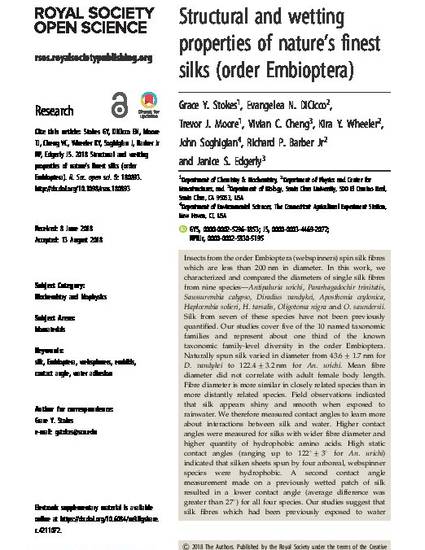
Insects from the order Embioptera (webspinners) spin silk fibres which are less than 200 nm in diameter. In this work, we characterized and compared the diameters of single silk fibres from nine species—Antipaluria urichi, Pararhagadochir trinitatis, Saussurembia calypso, Diradius vandykei, Aposthonia ceylonica, Haploembia solieri, H. tarsalis, Oligotoma nigra and O. saundersii. Silk from seven of these species have not been previously quantified. Our studies cover five of the 10 named taxonomic families and represent about one third of the known taxonomic family-level diversity in the order Embioptera. Naturally spun silk varied in diameter from 43.6 ± 1.7 nm for D. vandykei to 122.4 ± 3.2 nm for An. urichi. Mean fibre diameter did not correlate with adult female body length. Fibre diameter is more similar in closely related species than in more distantly related species. Field observations indicated that silk appears shiny and smooth when exposed to rainwater. We therefore measured contact angles to learn more about interactions between silk and water. Higher contact angles were measured for silks with wider fibre diameter and higher quantity of hydrophobic amino acids. High static contact angles (ranging up to 122° ± 3° for An. urichi) indicated that silken sheets spun by four arboreal, webspinner species were hydrophobic. A second contact angle measurement made on a previously wetted patch of silk resulted in a lower contact angle (average difference was greater than 27°) for all four species. Our studies suggest that silk fibres which had been previously exposed to water exhibited irreversible changes in hydrophobicity and water adhesion properties. Our results are in alignment with the ‘super-pinning’ site hypothesis by Yarger and co-workers to describe the hydrophobic, yet water adhesive, properties exhibited by webspinner silk fibres. The physical and chemical insights gained here may inform the synthesis and development of smaller diameter silk fibres with unique water adhesion properties.

Published by the Royal Society under the terms of the Creative Commons Attribution License http://creativecommons.org/licenses/by/4.0/, which permits unrestricted use, provided the original author and source are credited.